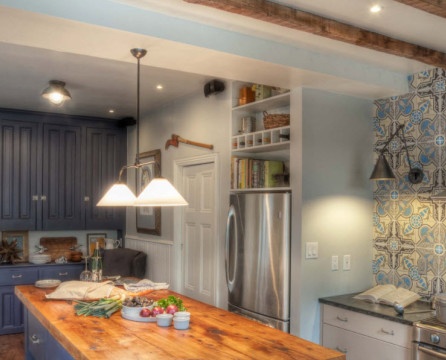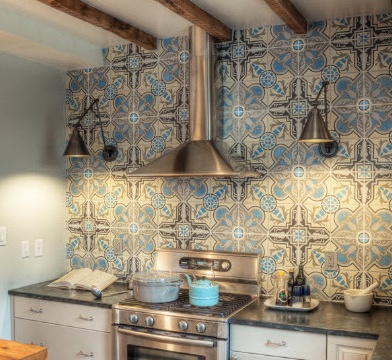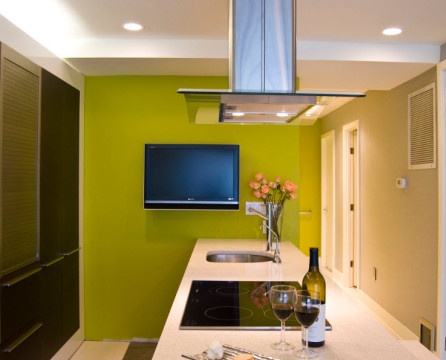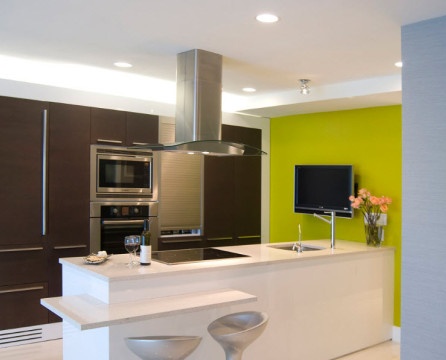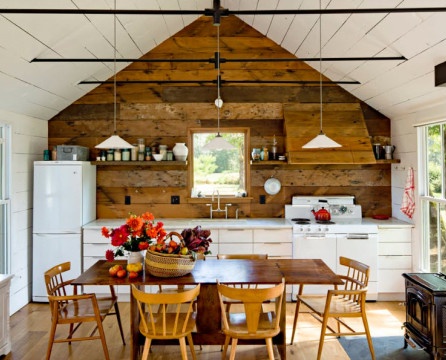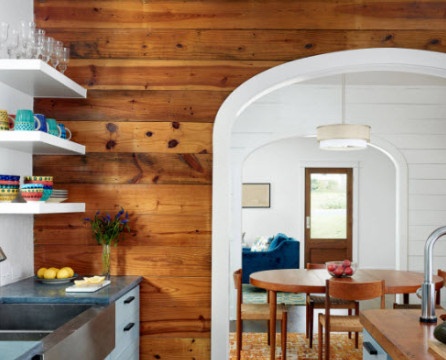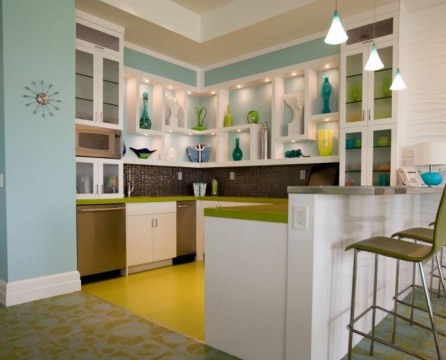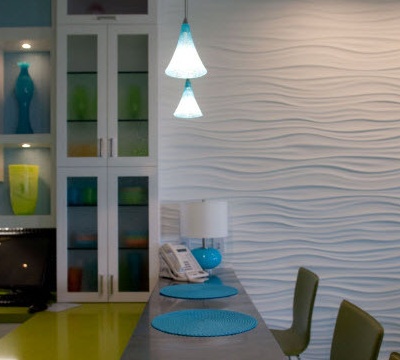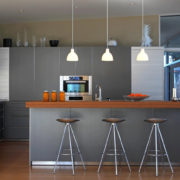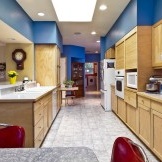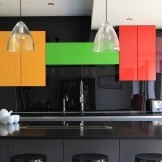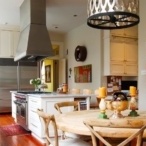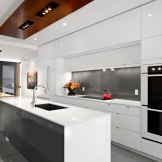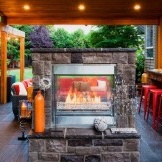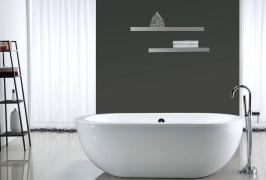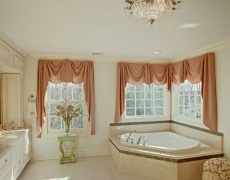Wall decoration in the kitchen - choose the best option
Literally every owner who plans to repair the kitchen space is faced with the problem of choosing finishing materials for the walls. The inevitability of the dilemma is associated with the specifics of the functionality of the kitchen - increased humidity, constant changes in temperature conditions, the presence of soot and drops of hot fat in the air. Despite the growing popularity of using fairly powerful range hoods, the walls in the kitchens of our compatriots are often exposed to various destructive factors. The good news for all homeowners who are starting a repair in the kitchen space is that there are enough materials that can emphasize the individuality of the interior and maintain an attractive appearance after exposure to all the above negative factors. But the choice still has to be made. In order to make it easier for you to navigate the variety of finishing materials, we have created a selection of relevant design projects for kitchen facilities, which have been designed using the most popular surface finishes to date.
Requirements for the finishing materials of the kitchen
Obviously, the choice of finishing materials is primarily influenced by the style of interior decoration and the basics of zoning the room on the working and dining segment. But because of the functional features, the specific microclimate of the kitchen facilities, there are also operational criteria for decoration materials:
- resistance to high humidity, splashes of hot water;
- preservation of the original appearance after exposure to high temperatures, drops of hot fat and soot;
- ease of care, which involves the possibility of cleaning surfaces (using cleaning products) with the subsequent preservation of the "salable" appearance of the finishing material;
- high level of hygiene - lack of a tendency to accumulate and multiply harmful microorganisms.
In the kitchen spaces of our compatriots, most often you can see the use of ceramic tiles or mosaics, painting and wallpapering the walls. Also used are wall paneling, decorative plastering. Of course, most often finishing materials are combined within the functional areas of the kitchen - the main factor in the separation is the presence of a working and dining area. It is a combination of finishing tools for certain functional segments of the kitchen that allows to achieve the maximum effect and the ratio of decorative and technological parameters.
Ceramic tile in the kitchen space
Ceramic tiles and mosaics are one of the most popular materials for facing surfaces in kitchens. When decorating a kitchen apron, ceramics become simply an indispensable tool for facing. This finishing material owes its incredible popularity to the following technological and decorative properties:
- durability;
- the ability to tolerate high temperatures;
- resistance to moisture, hot fat and other harmful factors;
- simplicity in leaving, a possibility of use of cleaners;
- a wealth of color and texture, variations on the size of the tile and its configuration;
- excellent compatibility with other finishing materials.
Conventionally, all ceramic tiles can be divided into the following types:
- smooth;
- textured (texture);
- glossy;
- matte.
To find a suitable version of ceramic tiles, which will not only perfectly protect the walls of the kitchen from various factors of influence, but also become an organic element of the interior, anyone who plans to repair in the kitchen room will be able to. There are many ready-made collections on sale, which include organically selected materials for facing floors, walls, aprons - there are decorative elements, various panels, borders, moldings and plinths.
It’s difficult to meet a kitchen design project in which all surfaces of the walls would be tiled. Nevertheless, in the modern interior of the kitchen, ceramics are most often found as an apron or wall decoration. Using ceramic tiles or mosaics, you can design the entire surface above the working area of the kitchen (the sector for placing the sink and hob or stove), making it an accent wall using color or texture.
Kitchen wall painting
For many of our compatriots, painting the kitchen walls becomes the most optimal finishing option, primarily because of the affordable cost of materials and the ability to independently carry out all the work. The ability to search for the desired shade using color mixing also acts as an advantage of such a finish. But it is important to understand that this way of decorating the walls requires considerable preparation - you need to have perfectly even and smooth surfaces for painting.
Moisture-resistant and washable paint is suitable for kitchen spaces. As for the color palette, the choice of options is diverse. Usually, using different shades of the same color in brightness, designers and their customers identify the food intake and working segment. But you can use fundamentally different colors - a bright, colorful tone for the dining area, pastel - for the working.
When choosing a paint color for decorating the walls of a kitchen, remember that cool colors - all shades of blue, green and their variations contribute to a decrease in appetite. But the tones of red, orange - will evoke not only positive emotions and adrenaline, but also a feeling of hunger. Of course, the choice of a color palette for wall decoration will directly depend on the range of kitchen facades. If your kitchen is presented in bright colors, then for decoration it is better to choose a light, neutral palette. And, on the contrary, for a color-neutral furniture ensemble, the colorful design of the vertical surfaces of the room will be an excellent companion.
Choosing between glossy and matte paint, it is important to understand that surfaces with a slight sheen look great and are even visually capable of enlarging the room, they wash well and do not collect dust. But on such walls the slightest roughnesses of surfaces are perfectly visible. If you are not sure about the ideality of the polished walls, then it is better to give preference to semi-matte and matte paints.
The mainstream of modern kitchen space design projects is the use of black paint to finish one wall. Such a surface becomes a kind of communicative base for households. On a dark surface, you can leave messages for each other, write down recipes or simply post photos, children's drawings, postcards and magnets brought from travels.
The choice of wallpaper for the kitchen
Beautiful and properly selected wallpapers can decorate any interior, including the kitchen. But it is important to choose the right type of this finishing material, which will correspond to the operational characteristics of the kitchen space. Obviously, ordinary paper wallpapers are not suitable for rooms with constant temperature changes, high humidity and the risk of surface contamination. Experts recommend the use of the following types of wallpaper for gluing the walls of the kitchen:
1.Vinyl - the top layer of such a finishing material is made of polyvinyl chloride, which is able to protect the walls from various mechanical influences and all kinds of pollution. Vinyl wallpapers are quite strong and durable (as much as this concept generally applies to wallpaper). In turn, this type of wallpaper is subdivided according to the type of production into those made on the basis of foamed vinyl and using hot stamping. Foamed vinyl has a very dense texture and is able to perfectly hide small flaws in the smoothness of surfaces.
Embossed wallpapers can be presented in the form of compact vinyl - they perfectly imitate stone, brickwork, plaster and even leather. Silk-screened wallpapers are characterized by a pleasant shine and smoothness of surfaces. If any type of vinyl wallpaper can be used to finish the dining area of the kitchen space, then for gluing the working segment it is better to give preference to fights with chemical embossing. Such wallpapers have sufficient strength and resistance to cleaning products, which are usually used for wet cleaning of the kitchen.
2.Non-woven - These wallpapers are very similar in their technological properties to vinyl products. The main difference is not a paper, but a non-woven base. In our country, non-woven wallpaper for painting is especially popular - they perfectly hide surface irregularities. In addition, the interior of the kitchen with similar wallpaper can be changed only by repainting the walls in a different shade.
3.Fiberglass or wallpaper using fiberglass - such products are highly durable. This type of wallpaper is also most often used for painting and has a number of advantages that are inherent in both vinyl and non-woven wallpapers.
Decorative plaster as a finishing material
Decorative plaster includes various finishing mixtures containing, in addition to the main components, various composite and binders - the smallest fractions of natural stones, cotton or linen fiber. Thanks to a wide range of color and textured solutions, designers and their customers are able to realize a wide variety of ideas for decorating the kitchen space.
Composite mixtures with the addition of stone chips have special strength, durability and original appearance. For a kitchen room that is prone to increased pollution, silicate types of decorative plaster are more suitable.
Conventionally, all types of decorative plaster can be divided into mixtures on an aqueous and anhydrous basis. For finishing the kitchen space, it is better to give preference to water mixtures - such materials do not have a chemical smell (neither during application, nor after drying).
If you choose decorative plaster for finishing kitchen walls, then the surfaces will need to be prepared. As in the case of preparation for painting, the walls will need to be leveled, plastered, sanded and primed. A pleasant moment when choosing this pitchfork finish is the fact that the process of applying directly plaster does not imply any special skills and can be done by the kitchen owners themselves.
Paneling of kitchen walls
Wall panels are made from various materials. One of the cheapest and easiest in terms of installation options are plastic panels. At the moment, this type of material is not popular, but it is still used in some cases and is mainly combined with other types of finishes. Plastic panels are able to withstand the effects of moisture and temperature extremes. But the strength and durability of this facing material leaves much to be desired. The environmental friendliness of raw materials is also not taken into account. But a wide range of colors and textures will please the modern buyer.
Recently, wooden panels for wall cladding have been in great demand.Some types of natural material practically do not undergo processing and integration of protective equipment. But any owner understands that dispensing with the processing of wood panels with antiseptics and protective varnishes, which will become a protection for a kitchen apron, cannot be dispensed with. Nothing brings warmth and coziness to the interior of a room like using a natural wood pattern. And to imagine an eco-style or country without wood trim is completely impossible.
Textured wall panels can transform any, even the most trivial, kitchen interior. The relief surfaces will look great in the dining area of the kitchen space. For a greater effect of visual perception of texture, such surfaces must be well illuminated.
Decorative stone to create an original kitchen interior
Among designers around the world, including Russian, decorative stone is very popular as a decoration material for various rooms. Kitchen space is no exception. It can be simplified to say that a decorative stone consists of sand, concrete, clay and gypsum. Artificial material can perfectly imitate various breeds of natural stone, but at the same time have the following advantages:
- decorative stone is much lighter than natural, which greatly facilitates the process of delivery and installation;
- sufficiently high strength properties, longevity;
- environmental friendliness of the material;
- lack of a tendency to the formation of mold, the multiplication of fungal bacteria;
- simplicity in leaving.
When choosing a decorative stone for the kitchen (as a room with a sufficiently high humidity), a material with water-repellent properties should be preferred. Otherwise, you will have to periodically spend time and money en coating surfaces with special compounds.
It makes sense to use a decorative stone as a facing material for all walls only in a very spacious room and when choosing a light color scheme. Such a finish can “absorb” a small kitchen space and visually reduce it even further. Artificial stone is perfect in metered application - as an accent wall finish.
Artificial stone is perfectly combined with other finishing materials. But it is important to understand that not every type of decoration will look harmonious if it does not get stylistically into the design. A romantic print on the wallpaper and stone surfaces will look strange in the same room. But with wood, neutral painting or wall decoration with decorative plaster, this type of finish will look organic.
If a fireplace is installed in the dining area of your fairly spacious kitchen (it doesn’t matter if it is an existing fireplace or only imitating the hearth), then cladding the surfaces with artificial stone will become the logical and most optimal finish. A combination of stone and fire, albeit artificial, will help to achieve an amazing, comfortable and cozy atmosphere.
Glass and metal in a modern kitchen design
Of course, such specific (and not cheap) materials, like glass and metal, are used for dosing kitchen surfaces dosed and mainly for facing an apron. Excellent technological properties, including resistance to moisture and temperature extremes, dripping hot fat and the tolerance of chemical cleaners, make stainless steel and glass plates an excellent way to protect the walls in the working area of the kitchen.
Stainless steel as a lining of a kitchen apron looks very modern, combining perfectly with chrome elements of household appliances. For the modern style and high-tech steel plates will be an excellent addition to the surface finish, not to mention the reliable protection of the walls in the most loaded sectors - the location of the sink and stove (hob).But it is important to understand that on an apron trimmed with a stainless steel sheet, any dirt, even traces of water drops and fingerprints, is clearly visible.
In modern design projects, recently one can often find the use of a large sheet of stainless steel as a finish for an entire wall (albeit a small one). Such a surface can be used as an exhibition wall, a base for placing a collection of magnets, leaving notes for households and placing recipes and shopping lists.
Tempered glass is able to withstand the highest temperatures, it is easy to care for and it can be presented in different color options. It is possible to apply photo printing on glass plates used for facing kitchen aprons (this, however, significantly increases the cost of finishing). Using glass trim, you can create a color accent in the interior of the kitchen space. In addition, glass surfaces with a slight gloss shine contribute to the visual expansion of the space.
Brickwork as part of the kitchen
Brick walls have become an integral part of the interior of rooms with different functional loads for many stylistic trends. Getting brickwork as an option for wall decoration can be done in several ways - using wall panels, special wallpapers. But the simplest and most effective method is the lack of plaster on a regular brick wall. Of course, for a kitchen space that is specific from the point of view of the microclimate, it is necessary to treat the brick walls with special sprays and varnishes, which create a protective layer from moisture and drops of hot fat.
“Allow yourself” the design of all the walls in the form of brickwork can only a very spacious room, decorated in the style of a loft. As a rule, a brick is used as an accent - color and textured. You can combine this type of wall decoration with both painting and pasting the surfaces with plain wallpaper.
One of the options for decorating a brick wall is painting with moisture-resistant paint. If you partially paint, you can achieve the effect of an aged surface. This finish will look great in a kitchen decorated in the style of shabby chic, vintage and even retro. Normal painting in bright colors will become a harmonious element of the interior, made in almost any style.























